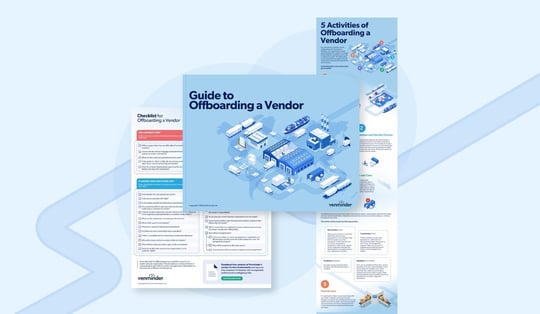
There’s a lot to consider when you decide to partner with a third-party vendor, but one critical item is often overlooked until it’s needed most – an exit strategy. Business engagements are rarely without their complications, and you don’t want to be stuck in an unfortunate situation with a vendor simply because you failed to create and test an exit strategy.
Planning for the potential end of a vendor relationship is your best insurance against any roadblocks or messy loose ends that can negatively impact your organization.
What Is a Vendor Exit Strategy?
A vendor exit strategy is necessary to develop for your critical and high-risk vendors. This won’t be a plan with step-by-step procedures, but rather a broad outline of some basic details of what’s involved when you exit the vendor relationship. In general, it describes which approach you’ll use to end the relationship, who will be involved, and the timing of implementation.
Think about one of your critical or high-risk vendors and ask yourself these questions:
- What happens if the vendor couldn’t provide the product or service to our organization or customers?
- What are the next steps if we need to terminate the vendor contract?
- How will we ensure that our organization’s data is returned or destroyed after contract termination or expiration?
This is why it’s crucial to have an exit strategy in place. It addresses these questions before you may be thinking about ending a vendor relationship and helps ensure that your organization can continue to operate after offboarding the vendor.
5 Considerations to Improve Your Vendor Exit Strategy
Occasionally, your third-party risk management team may flag a vendor that needs to be replaced. Maybe the issue is performance related, or the vendor failed in some other significant way. When this happens, you’ll want to be prepared by having a clearly defined exit strategy. Keep these tips in mind.
1. Choose a method.
If you were to decide that you need to offboard a vendor, it’s important to already have a method in place to ensure a smooth transition. Think through your options to determine which one will work best for your organization
In general, you'll choose from one of the following four options:
- Switching to a new vendor – It’s important to first verify that another vendor can service your organization if needed. You’ll need to consider the time needed to negotiate a contract and transition to this alternate vendor, as well as any additional costs. This alternate vendor should be identified during the vendor selection process, so you already have a backup in line if there’s a need.
- Absorbing the outsourced activity internally – Some organizations might find it worthwhile to bring the activity in-house; perhaps the activity even originated internally with your organization. This option would require you to carefully evaluate your capabilities.
- Terminating the activity – The third option is to simply discontinue the activity, though this still requires careful validation and testing. Consider how this termination will affect your operation or customers and whether there are any financial impacts.
- Combine the methods – In some cases, you may be able to use some sort of combination of the previous methods. Maybe you can switch to a new vendor for part of the outsourced activity and discontinue or absorb the rest.
2. Establish an exit strategy early.
It may seem a bit premature and unnecessary, but an exit strategy should factor into your high-risk and critical vendor selection process. That’s right, you’ll want to determine how to break up with a vendor even before you select one. Vendor relationships can quickly deteriorate and it’s essential to have an alternate or two in mind when you’re making your final selection. The “second place” vendor might be a suitable alternate, so make sure to keep their information on hand. Your third-party risk management team should ensure that there’s more than one vendor option for critical or high-risk activities.
3. Identify the roles and responsibilities.
Just like most other third-party risk management activities, the successful execution of an exit strategy is usually a team effort. Consider if you need approval from the board or senior leadership before terminating the vendor relationship. Also think about other departments you’ll need to notify within your organization, which may include your legal or IT team, and maybe accounts payable if there are any open invoices.
In addition to getting approval and notifying the appropriate teams, you’ll need to assign responsibilities well in advance to ensure there’s no confusion about who does what. Identify who will be sending the verbal and written notice of the termination to the vendor, whether that’s your vendor owner and/or your legal team. Someone should also be assigned to oversee the vendor throughout the termination to make sure they’re following contractual obligations.
4. Understand the specific risks involved.
No matter how much planning and preparation you do, ending a vendor relationship will have its risks. This is especially true if your vendor has access to your organizational or customer data. Data security and privacy are critical components of any exit strategy because of the increasing risk of third-party data breaches. Consider how these precautions can be incorporated into your exit strategy:
- The secure transfer of organizational and customer data, digital assets, and any equipment that the vendor may have.
- A method of data destruction that’s accepted by both parties. This may include a destruction of data certificate completed by the
vendor. - Assurance that the vendor has destroyed and/or removed all sensitive data from their systems. You may also want assurance that they haven’t shared your organization’s data intentionally or unintentionally with their third or fourth parties. One option is to request a full account of any fourth or nth party that will have access, transmit, process, or store your organizational or customer’s data.
5. Test the strategy for effectiveness.
Creating an exit strategy is a critical step, but how do you know if it’s going to be effective? While there’s no guaranteed method to ensure that your exit strategy is flawless, regularly validating and testing will help identify any areas that need improvement. For example, a functional test can reveal whether your existing resources are sufficient if you were to choose to bring the activity in house.
Always remember to document your testing results and review your exit strategy at least annually. You’ll want to know that any replacement vendors are viable, with the capacity and desire to serve your business should the need arise.
You should also consider whether any additional dependencies have been created with the vendor since the beginning of the relationship. Adding or discontinuing any products or services may affect your exit strategy’s effectiveness.

Vendor Contracts and Exit Strategies: 4 Best Practices
An exit strategy is an essential component of any vendor contract and will help ensure that both parties are acting accordingly when the relationship comes to an end. The details of your exit strategy will depend on many factors.
Here are some general best practices that will help create a strong vendor contract:
- Verify the transition period. Consider the timeline of your exit strategy and make sure you and your vendor agree on each other’s roles and responsibilities as you transition out of the relationship. This can help prevent any unexpected service disruptions that can affect your organization or customers.
- Confirm the criteria for early termination fees. Your vendor may implement early termination fees, particularly if they determine you’re ending the relationship without cause. It’s important to understand the details of these costs as they’re written in the contract, so you’re not facing any surprise fees.
- Establish a process for data handling. Whether you want your data to be returned to your organization or destroyed with a destruction of data certificate, those details should be included in the contract.
- Review regularly. Your exit strategy and contract should be periodically reviewed to make sure nothing warrants a change. This review schedule might be on an annual basis or whenever a significant event occurs like a data breach or unmet SLA.
Most organizations, if not all, will need to terminate a vendor relationship at some point. Sometimes a vendor simply isn’t working out and the best decision is to let the contract expire without renewal. Other times, early contract termination is the best solution to a significant vendor issue. Whatever the reason, an exit strategy is necessary to create a smooth transition during the vendor offboarding process.
Toolkit
Vendor relationships can end for many reasons. Your needs may have shifted, or you're looking for a different vendor that better aligns with your goals. Learn how to successfully offboard a vendor with this toolkit.

Related Posts
The Importance of an Exit Strategy in Vendor Management
Why do we want to go into a relationship thinking about the exit?
How to Offboard Vendors Successfully
We all know what it’s like at the beginning of a brand-new partnership. Oh, how those rose-colored...
What Is a Third-Party Risk Management Strategy?
Many organizations outsource products and services to third parties to supplement their...
Subscribe to Venminder
Get expert insights straight to your inbox.
Ready to Get Started?
Schedule a personalized solution demonstration to see if Venminder is a fit for you.
